Green comet 2023 – live: How best to see ‘awesome’ E3 in sky as it passes Earth at closest point
A green comet is about to fly past Earth before disappearing from our Solar System, never to be seen again.
The comet made its closest approach to Earth in the early hours of 1 February, 2023. At a relatively close 42 million kilometres (26 million miles) from Earth, it offers a rare opportunity for sky gazers to witness a comet.
The C/2022 E3 (ZTF) comet is so rare that woolly mammoths and saber-toothed cats were still roaming the Earth when it last swept by our planet 50,000 years ago.
At its perigee on Tuesday night and early Wednesday morning, the green comet had a brightness value of the magnitude of about +4.7, meaning it was possible to see it with the naked eye.
To find out where in the sky to look, and learn when conditions are best for viewing the comet, you can follow our live coverage in the blog below.
Key Points
Nasa ‘expecting new discoveries’ from green comet
Where the best viewing conditions for the green comet are right now
How to see the green comet
Live stream of green comet
02:02 , Anthony Cuthbertson
If it’s too cloudy where you are, or there’s too much light pollution, you can watch a live stream of the green comet passing Earth from various astronomers currently pointing their cameras to the sky.
There are numerous ones to choose from on YouTube, though none from any major observatory at the time of posting this.
Astronomers, amateurs share photos of green comet as it makes closest approach to Earth
06:45 , Vishwam Sankaran
Amateur space photographers and astronomers share photos of the green comet on Twitter as it makes close approach to Earth.
Fresh #CometZTF pictures hot off the @yorkobservatory 1m telescope Malincam ccd, even without processing it’s looking great. So glad the clouds parted tonight in #Toronto #C2022E3 #Comet pic.twitter.com/9Ycdaa48BT
— Dr. Hyde (@AstroHyde) February 1, 2023
Comet C/2022 E3 (ZTF) from Central Florida!
This image represents ~25min worth of data. Clouds and the Moon made this a difficult target to acquire.
Stacking & processing took many hours to get right.#Comet #CometE3 #CometZTF #C2022E3 #Astrophotography #Astronomy #Space pic.twitter.com/pBAJSRtZ4A— Ethan Walsh 🍥 (@EthanWalshPhoto) January 31, 2023
Comet C/2022 E3 (ZTF) imaged over 42 minutes this evening using the snazzy #Skywatcher 72ED and my Astro modified #EOS600d , 1 minute exposures, stacked in DSS and tweaked in photoshop #comet #astrophotograohy #sky #stars #C2022E3 #comet #startrails #astro #lookup pic.twitter.com/MeAjunFeX8
— Tim Burgess 🔭🚀 (@TimBurgess) January 30, 2023
How green comet ZTF was discovered
06:13 , Vishwam Sankaran
The green comet C/2022 E3 (ZTF) was found in March 2022, the discovery largely attributed to astronomers Bryce Bolin and Frank Masci.
While it was initially thought to be an asteroid, the space rock’s condensed coma – its nebulous envelope – indicated it was a comet.
The comet was spotted in a twilight survey by the Caltech-led project the Zwicky Transient Facility.
Comet ZTF over Mount Etna
Image Credit & Copyright: Dario Giannobile pic.twitter.com/2BqXH3DJ4d— Willie Aaron Lewis (@Parsec44) January 28, 2023
For the survey, ZTF uses a special camera to take images nearly every 30 seconds through the Palomar Observatory’s forty-eight-inch telescope.
Researchers have taught machine-learning algorithms to detect moving objects in the sky by analysing these images.
“On March 2nd, all we knew was that we had found a moving object. We reported it to the Minor Planet Center – they are the clearing house for these things,” Tom Prince, one of the lead scientists on the project, told The New Yorker.
Pictures of green comet posted to social media
06:09 , Graeme Massie
Nasa decodes distinctive shape of green comet
05:44 , Vishwam Sankaran
The green comet C/2022 E3 (ZTF) hurtling past Earth over the last month has been spotted to have not just one or two tails, but three.
Nasa notes in a blog post that the comet not only has a common dust tail, an ion tail, as well as a green gas coma, but also a rare distinctive anti-tail.
While the dust and ion tails are seen trialing comets, the ZTF’s anti-tail was seen seemingly leading the comet.
This anti-tail, seen in some photographs, is an illusion caused by the Earth moving through the comet’s orbital plane.
“The anti-tail does not actually lead the comet, it is just that the head of the comet is seen superposed on part of the fanned-out and trailing dust tail,” Nasa noted.
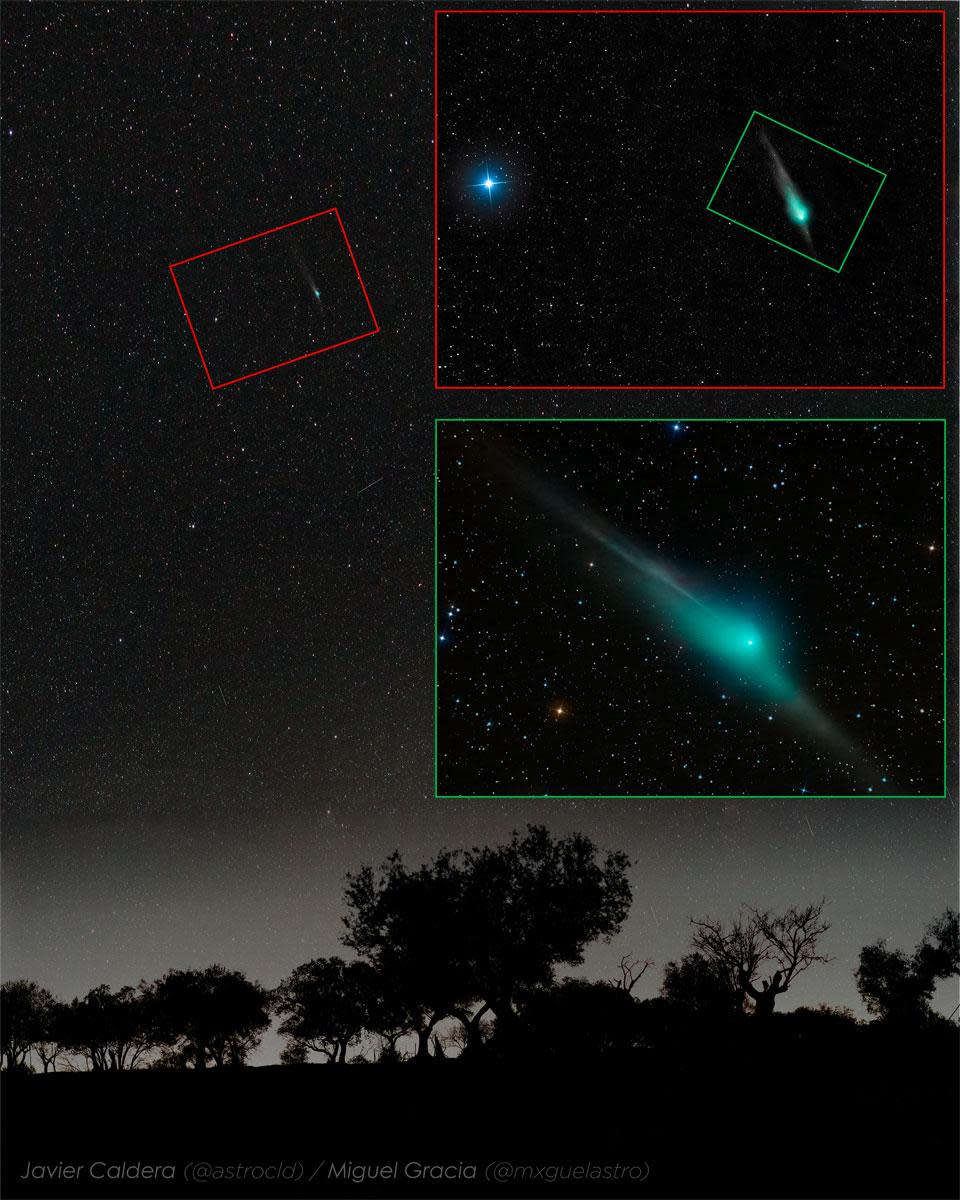
ZTF is currently visible all night long from northern latitudes, but is expected to fade from observation during the next few weeks and might never return to pass by Earth.
Some estimates suggest green comet may never again pass by Earth
05:19 , Vishwam Sankaran
Researchers say the green comet’s current orbit trajectory may see the space rock booted out of the inner Solar System to never return.
“Some predictions suggest that the orbit of this comet is so eccentric it’s no longer in an orbit—so it’s not going to return at all and will just keep going,” astronomer Jessica Lee from the Royal Observatory Greenwich told Newsweek.
While scientists do not yet have an accurate estimate of how far the comet could get from the Earth, they say if it does return, it may not for at least another 50,000 years.
Whether it returns or not may depend on the perturbations the comet may encounter from losing its mass or from any disturbances it might face while in the Oort cloud.
The green comet’s path through the sky
05:03 , Graeme Massie
Tonight is not the only chance to see the green comet, so don’t lose hope if the weather near you is bad.
This handy map, courtesy of the MISAO Project, shows the path the comet will be taking across the sky over the coming days and weeks.
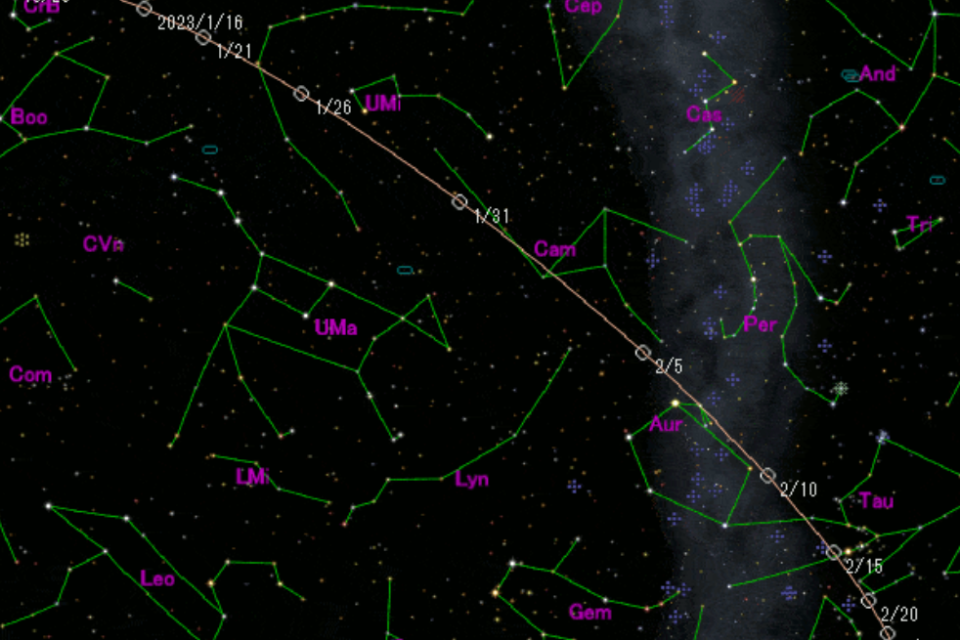
The early hours of 1 February will see Comet ZTF reach its perigee, meaning it is at its closest point to Earth, but it will still be visible with the naked eye for the next few days in case you don’t get a chance to see it tonight. For a few weeks it will also be possible to see it using binoculars or a telescope.
What we know about Oort cosmic cloud from where green comet originated
04:53 , Vishwam Sankaran
The green comet C/2022 E3 (ZTF) making its closest pass by Earth today originated from the Oort Cloud, a cosmic shell of debris encircling the farthest reaches of the Solar System.
Scientists have long known that this region, containing billions or trillions of space debris, is the origin site of long-period comets like ZTF.
This region is thought to be a giant spherical shell encircling the Solar System like a thick-walled bubble made of icy rocks.
It is likely at a massive distance of about one-quarter to halfway from the Sun to the next star, according to Nasa.
Scientists have theorised that this region likely formed as gravity from the Solar System’s planets shoved a vast number of icy rocks away from the Sun, and gravity from the galaxy may have caused debris to settle into a border shell.
The comets from this shell can shed light on the history of the Solar System and have been seen only once in recorded history since their orbital periods are very long.
Nasa to study green comet using Webb telescope
04:30 , Vishwam Sankaran
Nasa is planning to observe the comet with its James Webb Space Telescope to unravel clues about the Solar System.
The comet may shed light on the formation of the Solar System as it likely formed during its early stages, scientists say.
It was first identified by the wide-field survey camera at the Zwicky Transient Facility inside the orbit of Jupiter in March 2022 but was initially suspected to be an asteroid.
“We’re going to be looking for the fingerprints of given molecules that we can’t access from the ground,” planetary scientist Stefanie Milam of NASA’s Goddard Space Flight Center in Maryland said.
“Because JWST’s so sensitive, we’re expecting new discoveries.”
04:04 , Graeme Massie
What we know about green comet's chemical composition
03:53 , Vishwam Sankaran
The comet’s green colour is due to the effect of sunlight on its molecules cyanogen and diatomic carbon.
The latter is a green, gaseous chemical with the chemical formula C=C that occurs in the carbon vapour in comets.
These molecules are broken down by sunlight into single carbon atoms before they move into the comet’s tail.
Thus the green colour is limited to the space rock’s icy nucleus while the tail may still appear white in contrast.
How was Earth last time green comet zoomed past planet
03:30 , Vishwam Sankaran
The green comet formally known as C/2022 E3 (ZTF) last zoomed past Earth 50,000 years ago as the planet was in the middle of its last ice age.
Earth was home to wooly mammoths and mastodons with large glaciers covering most of Europe and North America. Large mammals like wombats the size of rhinos and giant kangaroos lived in Australia during this time.
Both modern humans and Neanderthals lived together 50,000 years ago in parts of Europe when the comet last passed by.
The space rock belongs to a class of long-period comets that take about 200 years to 1 million years to complete their transit around the Solar System.
Best places in California to watch the skies
03:03 , Graeme Massie
UCLA physics and astronomy lecturer Art Huffman suggests the following locations for watching the skies above California.
1. Joshua Tree National Park
2. Death Valley National Park
3. Red Rock Canyon State Park near Bakersfield
4. Anza Borrego Desert State Park near San Diego
Nasa ‘expecting new discoveries’ from green comet
00:02 , Graeme Massie
If you’re wondering what gives the comet its unusual colour, we’ve heard from astronomers at Caltech’s Palomar Observatory in San Diego.
They explain that its “greenish, emerald hue reflects the comet‘s chemical composition – it is the result of a clash between sunlight and carbon-based molecules in the comet‘s coma.”
Nasa scientists will be observing this tale, which stretches to a similar diameter as the Moon in the night’s sky, to look for the fingerprints of molecules that they can’t access from the ground. “Because JWST’s so sensitive, we’re expecting new discoveries,” said planetary scientist Stefanie Milam from the US space agency’s Goddard Space Flight Center in Maryland.
You can read all about our celestial visitor here:
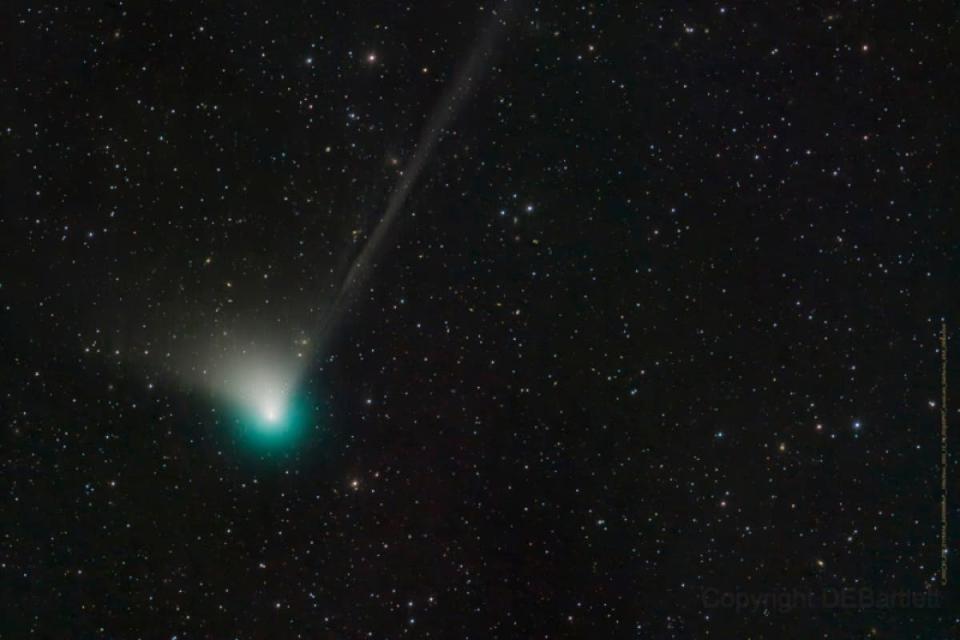
What to expect as ‘green comet’ hurtles towards close encounter with Earth
Green comet sightings in UK hindered by cloud
Tuesday 31 January 2023 22:27 , Anthony Cuthbertson
The Met Office is showing patchy cloud over most of the UK and Ireland for the next few hours, with the north of England and Scotland nearly completely covered.
The best places to currently catch a view of the green comet are in the Midlands, while southern areas of England will begin to get a bit clearer at around 3am. North eastern Scotland will also see a window of clear skies open up at around 6am, right up until 8am when the Sun begins to rise north of the border.
Peering through the patches of cloud on Tuesday night and early Wednesday morning may be the best chance to view the comet, with heavy cloud rolling in during the day that will stick around until the weekend.
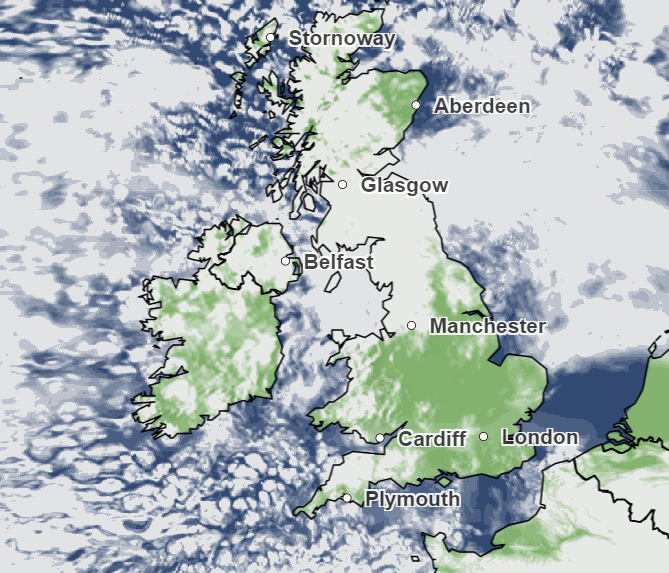
Photos of the green comet show fuzzy trail
Tuesday 31 January 2023 21:52 , Anthony Cuthbertson
People have been sharing their photos of the green comet on social media, revealing good shots of its glowing trail.
I FINALLY got to see the GREEN COMET! pic.twitter.com/O95NpkmN0D
— 🔭AstroBackyard (@AstroBackyard) January 31, 2023
Managed to capture it too this week! Super stoked pic.twitter.com/47BJVdHhmc
— Stijn Orlans (@StijnOrlans) January 31, 2023
How to see ‘once-in-a-lifetime’ comet with the naked eye
Tuesday 31 January 2023 21:00 , Anthony Cuthbertson
The Royal Observatory has offered advice on how to see tonight’s green comet, which it describes as a “once-in-a-lifetime” event. Last visible from Earth 50,000 years ago, it’s more like a once-in-an-epoch event, and it may be the last time it ever passes Earth, according to astronomers’ projections.
Here’s what the observatory had to say:
Comet C/2022 E3 (ZTF) will be closest to Earth on 1 February. This will also be the moment the comet appears at its brightest, and currently it is expected to reach a brightness magnitude of +6. That would mean it would be visible to the naked eye.
In fact, the green comet is already being reported to be brighter than +6, with some comet-spotters reportedly seeing it with the naked eye from places with very dark skies.
It’s worth noting however that comets can be unpredictable, and it’s hard to say with accuracy how bright the comet will be or what it will look like ahead of time.
The comet looks like a fuzzy green ball or smudge in the sky.
Royal Observatory
Nasa says green comet is ‘awesome opportunity'
Tuesday 31 January 2023 19:07 , Anthony Cuthbertson
Nasa described Comet C/2022 E3 (ZTF) in its latest ‘What’s Up’ blog for January. Here’s what the US space agency had to say:
“Observers in the Northern Hemisphere will find the comet in the morning sky, as it moves swiftly toward the northwest during January.(It’ll become visible in the Southern Hemisphere in early February),” the blog states
“This comet isn’t expected to be quite the spectacle that Comet Neowise was back in 2020. But it’s still an awesome opportunity to make a personal connection with an icy visitor from the distant outer solar system.”
Where the best viewing conditions for the green comet are right now
Tuesday 31 January 2023 18:57 , Anthony Cuthbertson
Current forecasts from the UK Met Office show that large parts of the UK and Ireland are covered in cloud at the moment, with Scotland almost entirely blocked out.
The good news is that most of the east and south of England are currently clear, so viewing conditions to see the green comet could be ideal for many.
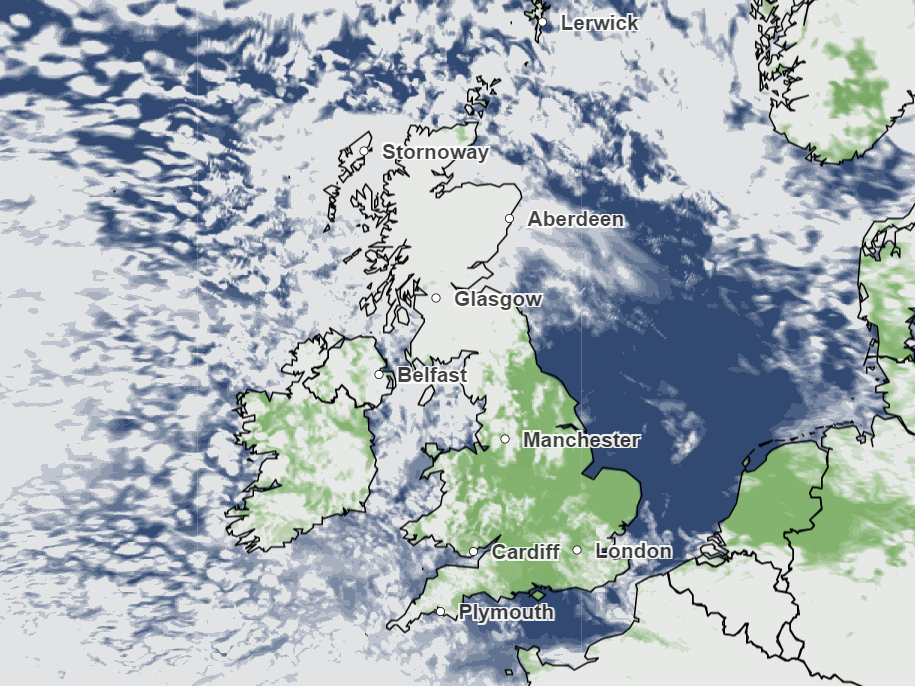
How to see the green comet tonight
Tuesday 31 January 2023 15:41 , Anthony Cuthbertson
Anyone in the Northern Hemisphere has a chance of seeing Comet C/2022 E3 (ZTF) tonight, though substantial cloud cover could hinder sightings.
At its closest point to Earth in the early hours of Wednesday morning (UK time), the comet will be visible near the constellation Camelopardalis.
The easiest way to find it in the night sky is by either using a star map, or by downloading an astronomy app that can uses your phone’s accelerometer to point you in the right direction. Popular apps include SkyView Lite, SkySafari and Sky Map.
You can find out more details on how to see the green comet here:
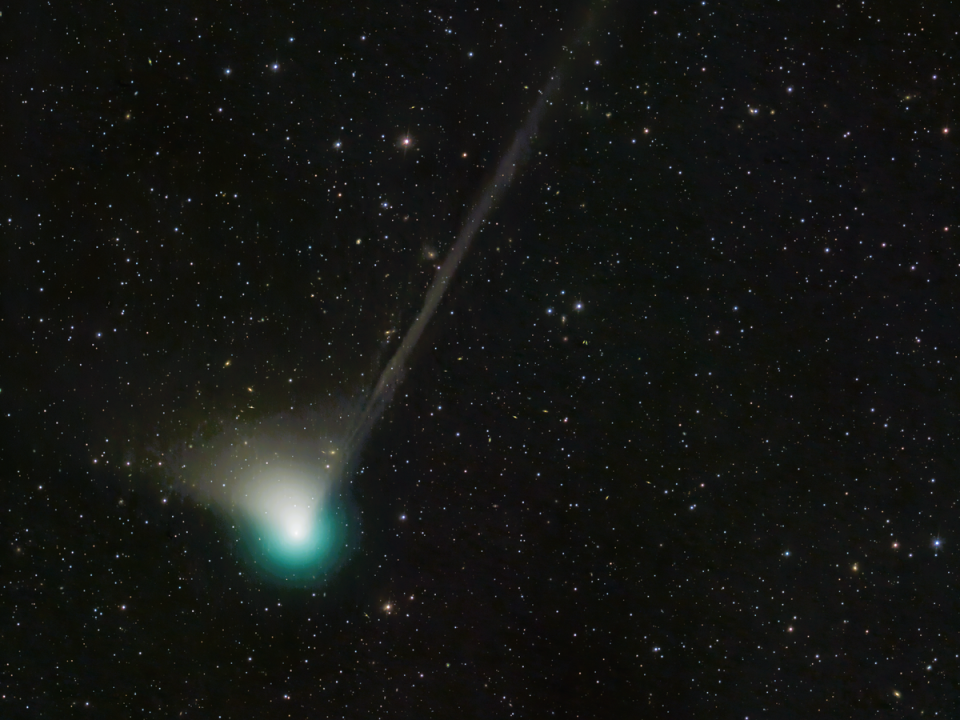
How to see the spectacular green comet from Earth tonight
Hello and welcome...
Tuesday 31 January 2023 11:59 , Anthony Cuthbertson
to The Independent’s live coverage of the C/2022 E3 comet, which is making its closest approach to Earth in 50,000 years tonight.
We’ll have all the latest weather news and tips on how best to see the green comet as it passes our planet.


